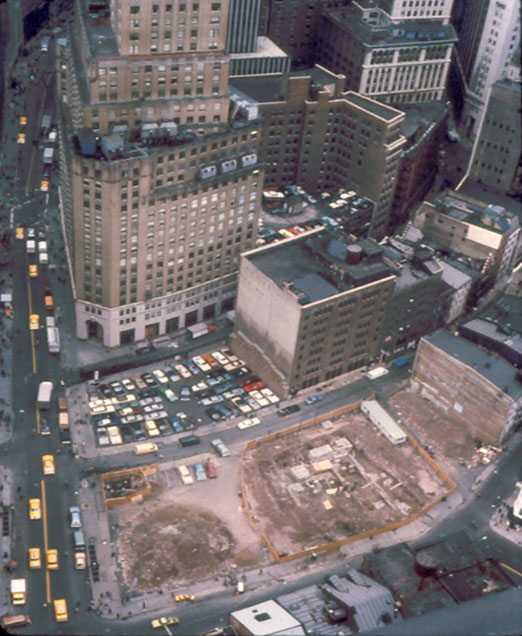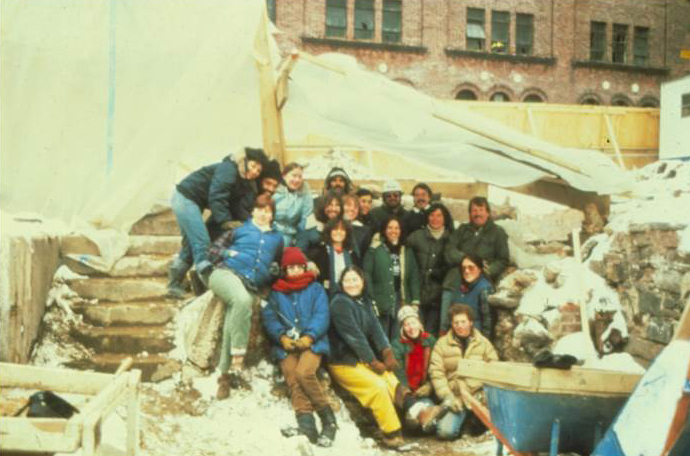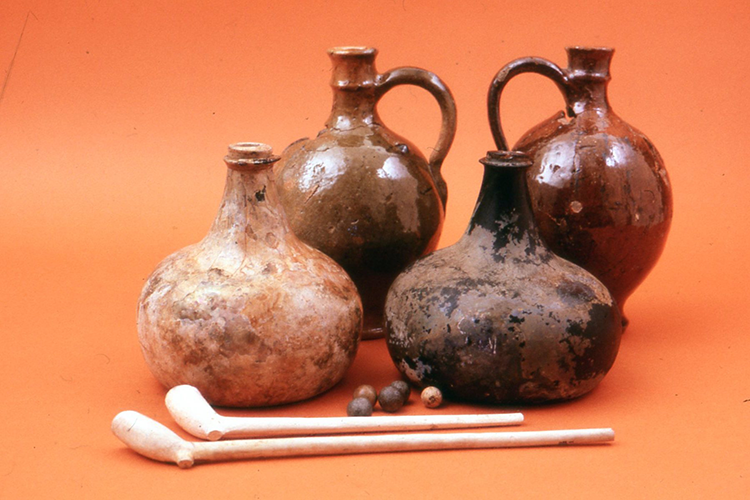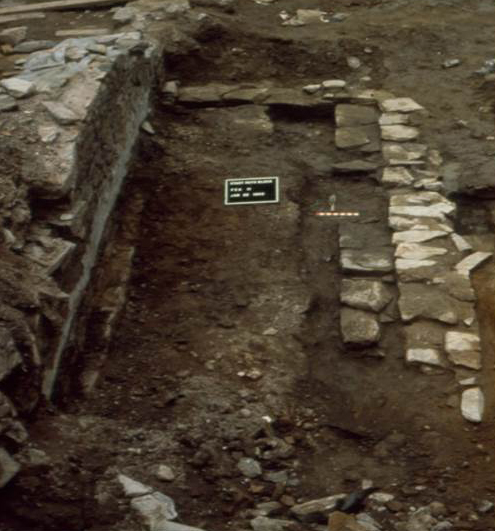The Archaeological Excavation of the Stadt Huys Block in Lower Manhattan
by Nan A. Rothschild and Diana diZerega Wall
 The first large-scale archaeological excavation in New York City took place in the Wall Street district in 1979–1980. The project came about when the developers of the office building that became the headquarters of Goldman Sachs had to “dedesignate,” or undo, the site’s prior designation as a New York City Landmark. The landmarked building had been torn down a decade earlier and its façade was to be re-erected at another site, but the façade had been lost. In addition, preservation practices had changed, and archaeologists had begun to dig up downtown. So the Landmarks Preservation Commission decided to promote an archaeological excavation on the block to satisfy the dedesignation status and to use it as a test case to see if important archaeological finds could remain buried in one of the most urbanized places in the world. This particular block was exciting because it was located in old Dutch New Amsterdam and was the site of the first Dutch town hall (Stadt Huys), built originally as a tavern (the Stadt Herbergh) in 1642. As one of the only secular large public buildings in the new town, it was appropriated as the town hall when New Amsterdam was incorporated as a municipality in 1653.
The first large-scale archaeological excavation in New York City took place in the Wall Street district in 1979–1980. The project came about when the developers of the office building that became the headquarters of Goldman Sachs had to “dedesignate,” or undo, the site’s prior designation as a New York City Landmark. The landmarked building had been torn down a decade earlier and its façade was to be re-erected at another site, but the façade had been lost. In addition, preservation practices had changed, and archaeologists had begun to dig up downtown. So the Landmarks Preservation Commission decided to promote an archaeological excavation on the block to satisfy the dedesignation status and to use it as a test case to see if important archaeological finds could remain buried in one of the most urbanized places in the world. This particular block was exciting because it was located in old Dutch New Amsterdam and was the site of the first Dutch town hall (Stadt Huys), built originally as a tavern (the Stadt Herbergh) in 1642. As one of the only secular large public buildings in the new town, it was appropriated as the town hall when New Amsterdam was incorporated as a municipality in 1653.
We (the authors) had gone to graduate school together at New York University and had worked together on other projects. We agreed to undertake this challenging excavation with the support of our mentor, Bert Salwen of NYU. But since there had been no archaeological projects on this scale or in such a densely developed portion of the city, we had no idea whether we would find anything important or not—that is, any layers of soil that could tell us about life in early New Amsterdam/New York.
We began the project as archaeologists always do, by scouring archives and libraries for old maps and records that could tell us about the history of the property—the buildings that had stood there and the people who had lived and worked there throughout the block’s history. The block was made up of twenty-one separate building lots, and we eliminated the lots with the most modern structures as these all had deep basements, the construction of which would have destroyed seventeenth- and eighteenth-century materials. We were left with ten lots that had shallow basements, and more-or-less intact back yards.
The project was unlike any either of us had ever worked on in several ways. First was the nature of the work itself: it required back-hoes and front endloaders, construction equipment that we had never worked with. Their job was to clear the site of the remains of the parking lot which was on the site when we began the excavations and to remove the debris within the underlying basements on each lot down to the cellar floor of the most recent buildings that had been on it. After lifting those floors, the “real” archaeology, using shovels and trowels, and sifting all the dirt that we excavated through 1/4” mesh, began. Secondly, we were lucky to have a large, enthusiastic crew, made up mostly of graduate students and other experienced workers. However, many of them were women, and we were on the payroll of a construction company which provided support, and the construction company’s crew was mostly male. Although they were very helpful, it took all of us a bit of time to get used to working with one another. We did end up having a comfortable relationship with the construction crew.
 We excavated, off and on, for a year. We worked through the winter, sometimes using plastic shelters with kerosene heaters. As this block was in the midst of New York’s financial district, there was a lot of curiosity about the project. Bystanders would ask: “is this a project for women in engineering?” Or “what are you looking for, gold?” or, more knowledgably, “for Peter Stuyvesant’s wooden leg?”
We excavated, off and on, for a year. We worked through the winter, sometimes using plastic shelters with kerosene heaters. As this block was in the midst of New York’s financial district, there was a lot of curiosity about the project. Bystanders would ask: “is this a project for women in engineering?” Or “what are you looking for, gold?” or, more knowledgably, “for Peter Stuyvesant’s wooden leg?”
The site stratigraphy—that is, the layers of soil that made up the site and often marked changes in the use of a particular area—was as complicated as we had anticipated. What we had not expected was the volume of artifacts that we found: many kinds of broken dishes, glass (from glassware and windows), pipe stems, animal bone and shell, and architectural materials such as tiles, roofing materials, thousands of rusty nails, and bricks. Some of these things could be identified as having been made in Holland, England, or France, and some were made in America. Although most dated to the eighteenth and nineteenth centuries, some dated to the seventeenth century as well. All in all, we recovered literally more than two tons of artifacts! And all of them had to be processed—cleaned, inked with an identifying number, classified by function and material, and then stored, a very time-consuming operation. In addition, the stratigraphy had to be analyzed and a report written that described the excavations and the discoveries that were made. It usually takes three times as long to do the work following excavation as it does to conduct the excavation itself. The report on the Stadt Huys Block was completed in 1987. The artifacts are now housed at the New York City Archaeological Repository, in midtown Manhattan, which is managed by the NYC Landmarks Preservation Commission, and many can be seen online at: archaeology.cityofnewyork.us.
The most exciting things we found were those structures archaeologists call features. These include the remains of wells, cisterns (for water storage), and privies (the shafts from outhouses) in the backyards behind some of the early houses. These are important because people tended to use them to dispose of trash, including broken dishes or other objects, along with the remains of meals (shell and bone). We found quite a few features, including an eighteenth-century well and several dating to the nineteenth century. We also found layers of relatively undisturbed old ground surfaces, or what archaeologists call “A Horizons,” under Stone Street, one of the oldest streets in New York. These layers of organic soil interspersed with fill dated from the early nineteenth century all the way back to the 1650s.
 Although we did not find any remains from the foundation wall of the Stadt Huys itself—it seems that its traces were destroyed when the property was re-developed at the turn of the nineteenth century—we did make a spectacular discovery. We uncovered the foundation wall and cellar deposits from the King’s House [Lovelace Tavern], a tavern that had been built in 1670 just next door to the Stadt Huys and had served as a temporary town hall when the original one was thought unsafe to use. We identified this tavern only as our field work was ending, when we excavated a series of small excavation units that yielded a large number of broken tobacco pipe stems and wine bottle fragments dating to the late seventeenth century—just what one would expect to find in a tavern! When we realized that these were finds from the tavern, we applied to the Landmarks Preservation Commission for an extension of the project and additional funds to excavate a larger sample of the tavern remains. These were granted, extending the project through the summer of 1980.
Although we did not find any remains from the foundation wall of the Stadt Huys itself—it seems that its traces were destroyed when the property was re-developed at the turn of the nineteenth century—we did make a spectacular discovery. We uncovered the foundation wall and cellar deposits from the King’s House [Lovelace Tavern], a tavern that had been built in 1670 just next door to the Stadt Huys and had served as a temporary town hall when the original one was thought unsafe to use. We identified this tavern only as our field work was ending, when we excavated a series of small excavation units that yielded a large number of broken tobacco pipe stems and wine bottle fragments dating to the late seventeenth century—just what one would expect to find in a tavern! When we realized that these were finds from the tavern, we applied to the Landmarks Preservation Commission for an extension of the project and additional funds to excavate a larger sample of the tavern remains. These were granted, extending the project through the summer of 1980.
 When the archaeological aspect of the project was complete, and as the findings came to be known, the public became interested in preserving some of the structural remains of the early block. So an exhibit was created on the Goldman Sachs plaza at 85 Broad Street. There, pavers were used to outline the walls of the Stadt Huys and the King’s House/Lovelace Tavern and, under glass, the remains of part of the tavern wall was recreated, as was the eighteenth-century well. The exhibit exists to this day, although it was somewhat damaged in 2012 by Hurricane Sandy.
When the archaeological aspect of the project was complete, and as the findings came to be known, the public became interested in preserving some of the structural remains of the early block. So an exhibit was created on the Goldman Sachs plaza at 85 Broad Street. There, pavers were used to outline the walls of the Stadt Huys and the King’s House/Lovelace Tavern and, under glass, the remains of part of the tavern wall was recreated, as was the eighteenth-century well. The exhibit exists to this day, although it was somewhat damaged in 2012 by Hurricane Sandy.
Because of the success of the Stadt Huys Block project, there are regulations on the federal, state, and local levels that apply to New York City and specify that, under some circumstances, archaeological sites are protected. For example, if a developer applies for a zoning variance to build an extra-tall building, that project will undergo environmental review and the NYC Landmarks Preservation Commission will determine whether or not there could be an important archaeological site on the property that would be destroyed by the new development. If it appears that there could be, the regulations require that the developer undertake an archaeological study of the property.
Since the Stadt Huys Block excavations, there have been scores of archaeological studies done in New York prior to development. However, there are also circumstances in which important sites are not protected. For example, if a developer is building an “as of right” building, for which no special permits are needed, he could destroy an important site with impunity. But overall the excavations were a great success. We uncovered some important finds—important enough so that the Landmarks Preservation Commission could use them in buiding an argument to put regulations protecting archaeological sites into place.
Nan A. Rothschild is an archaeologist who has conducted field work primarily in New York City and New Mexico. She teaches at Columbia University and is Ann Whitney Olin and Research Professor at Barnard College. The Stadt Huys Block project, co-directed with Diana Wall, was the first large urban project in which she was involved. She has published The Archaeology of American Cities, co-edited with Diana Wall (University Press of Florida, 2014), New York City Neighborhoods: The 18th Century (Percheron Press 2008), and Colonial Encounters in a Native American Landscape (Smithsonian Institution Press 2003), among other books and articles.
Diana diZerega Wall is an archaeologist who specializes in New York City from the seventeenth through the nineteenth centuries. Her interests include the construction of class, race, and gender. Professor Emerita at City College and CUNY Graduate Center, she holds a PhD from New York University. Her books include The Archaeology of American Cities (with Nan Rothschild, 2014) and the award-winning Unearthing Gotham (with Anne-Marie Cantwell, 2001). She is currently working on two books, one (with Anne-Marie Cantwell) on New Netherland, and one (with Nan Rothschild) on Seneca Village, the nineteenth-century African American community that was located in today’s Central Park.









































































